You might have come across little black bugs in your house furniture, walls, carpet, and many other places. There’s no need to go full-on exterminator mode as these bugs are probably of little to no harm to you and your family.
But the question is, how will you identify these types of little black bugs in your house? Are there safe and easy options to get rid of them?
The most common little black bug in the house is the carpet beetle. However, those bugs you see could possibly be grain insects, such as weevils, fleas, pill bugs, or centipedes.
See if they fly, leave a trace, or leave a foul smell when squashed. Also, check their shape and distinct physical characteristics, such as hard shells. This way, you can assess what they are and how you can quickly get rid of the bug infestation, without having to call professional help.
In this article, we’ll look at 5 common little black bugs:
- Black Carpet Beetles
- Grain Insects
- Fleas
- Pill Bugs
- Centipedes
I’ll also list 7 tips for getting rid of the little black bugs:
- Clean Out Your Pantry
- Tidy Up Your Dresser and Closets
- Use Diatomaceous Earth
- Try Peppermint Oil
- Use Neem Oil
- Throw Away Standing Water
- Ventilate at Risk Areas
Read on to learn more about the little black bugs in your house and tips for getting rid of them.
Little Black Bugs in House
Some of the most common little black bugs in house fixtures, food, plants, and other items may all look similar. However, these critters have unique characteristics. The secret is knowing how to identify the types of bugs you have in your home so you can find the best and safest option to get rid of them.
How to Identify Little Black Bugs in House
The best way to identify little black bugs in your house is to use your senses. Your eyes are the best tool to spot these critters, no matter how tiny they are. Observe them first and try not to disturb them too much so as not to scare them away. This will let you trace where they feed and lay their eggs.
If you accidentally squash little black bugs in your house with your shoes and noticed a black or brown smear, you probably have a case of carpet beetles. And if you see them launching into the air, you might be looking at a springtail.
Another way to identify these bugs is to continually check on your pets and be mindful of any skin irritation that you may develop. If you have small insect bites, you might have fleas or bed bugs in your living space.
Common Little Black Bugs in House
Many bugs or insects can come and go in the home, but the most commonly seen bug is probably the carpet beetle. You often see these little tiny bugs in house carpets – hence the name – and some in your pantry or closet.
Here are 5 of the most common little bugs that appear in homes and their details:
1. Black Carpet Beetles
- Scientific Name: Attagenus unicolor
- Size: approximately 1/16 to 1/8 inch long (about the size of a pinhead)
- Appearance: Convex, round, or oval
Carpet beetles feed on fibers of carpets and clothes, pet foods, and even cereals. These beetles are difficult to spot as they do not reproduce quickly, but most homes have a few of these for sure. Carpet beetles are harmless to humans and are not known to cause any diseases.
They also have the unique ability to digest keratin, the protein found in hair, skin, or fur. Carpet beetles also like wool and silk and are especially fond of cereals.
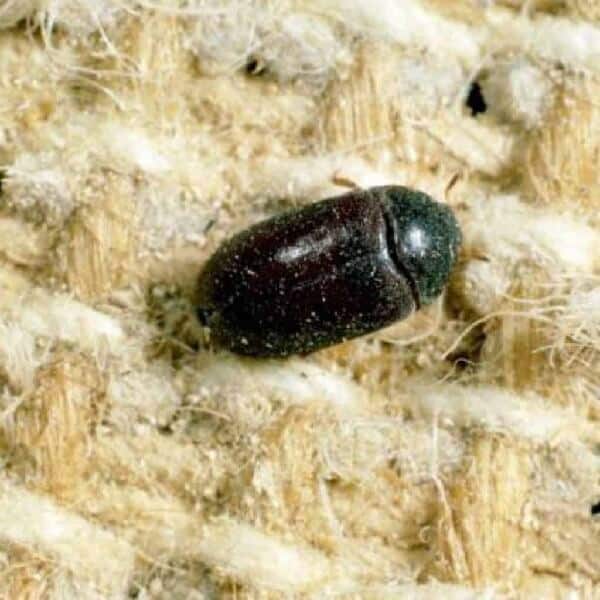
2. Grain Insects
These little tiny black bugs may be a cause for worry, especially if there’s a lot of them. They can get into food storage through bought grains or flour products and feed on your food stockpile, slowly lowering its quality. There are about seven different types of grain insects, which infest houses.
Weevils
- Types: Rice weevils (fliers) and granary weevils (non-fliers)
- Difficult to control pests (present in stored products)
- Weevils create a ‘shot-hole’ appearance on a grain where they lay their eggs
- Adult weevils have a lifespan of 7 to 8 months
- Female weevil lays 50 to 250 eggs per lay
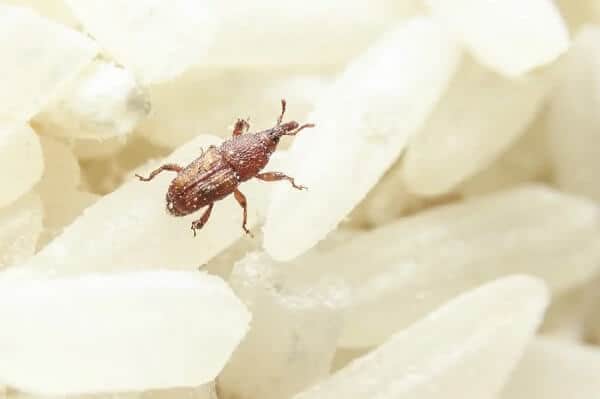
Flour Beetles
- Types: Black flour beetle, red flour beetle, confused flour beetle
- Affects cereal grains, flours, seeds, and other grain products
- Leaves a disagreeable odor and foul taste in the products affected
- Can live up to 18 months and are very prolific in laying eggs
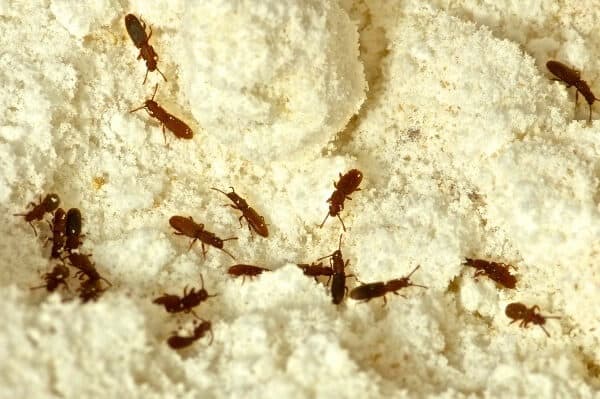
3. Fleas
Fleas are notorious for latching onto pets just to wreak havoc in your house. That’s why they are the most unwelcomed little black bugs at home. They are tiny and difficult to spot at times. Moreover, they are the little black bugs that bite in house, especially during warmer months. It can be annoyingly painful not just to your pets but to your whole family.
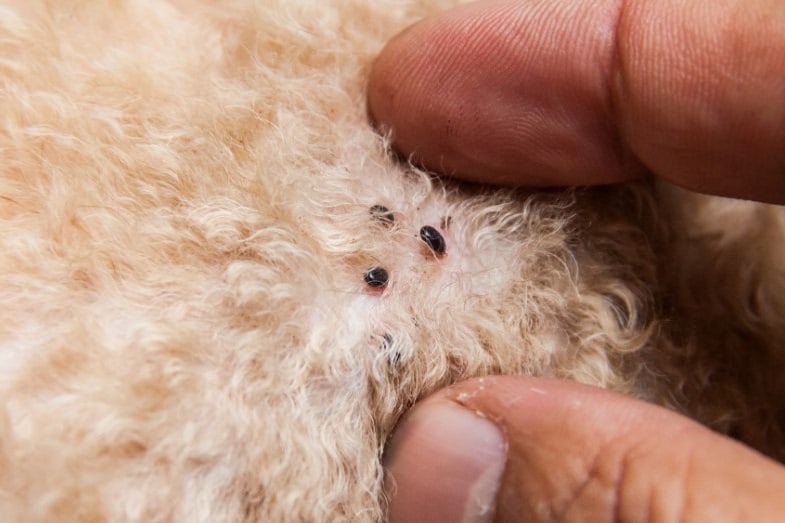
4. Pill Bugs
- Scientific Name: Armadillidium vulgare
- Size: ¼ to 5/8 inch long
- Appearance: Has seven pairs of legs, two pairs of antennae, and seven hard individual exoskeletal plates
Pill bugs are actually crustaceans that have adapted to living solely on land. These little tiny black bugs in house thrive in areas with adequate moisture, so you would typically find them around flower pots and stones during the night.
Also called rollie pollies, they can roll into a tight ball as a defense mechanism. Pill bugs are nocturnal insects that hide during the day and go out at night to feed on decaying house flowers and vegetables.

5. Centipedes
Centipedes are some of the creepiest critters, probably even more frightening than cockroaches. You can find these little black bugs in house walls and floor, crawling along looking for their next meal. Creepy as they are, centipedes help rid homes of other pests such as flies, termites, moths, silverfish, and even cockroaches.
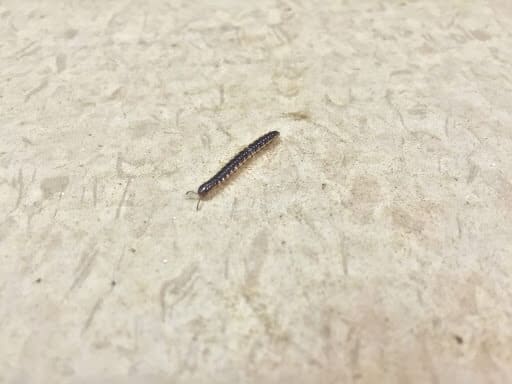
Check out this article on HomeCareZen.com, if you see tiny white bugs in your kitchen. And take a look at the post on gray bugs if you see gray bugs.
How to Get Rid of Little Black Bugs in House
Having these little tiny black bugs in the house can really be a cause for concern. And panicking about it will not help get rid of them at all! You might want to turn to pesticides and other chemical compounds to get rid of these little black bugs fast. However, you have to consider the health and wellness of your family and pets, too.
Here are some of the safest, easiest, and natural ways to get rid of little black bugs in the house:
1. Clean Out Your Pantry
Most insects stay in your home because it is a treasure trove of food and a cozy place to live in and reproduce. Little black bugs in house pantries damage food stocks by lowering their quality until the stocks are no longer edible. That is why you must clean out your pantry so that no food item is left unchecked.
2. Tidy Up Your Dresser and Closets
Little tiny black bugs in house carpets and closet drawers, such as carpet beetles, feed off the fibers in cloth fabrics, which can be such a pain to clean. By tidying up your dresser and closets from time to time, you can be sure to get rid of shed skin and larvae. It will also discourage the proliferation of these little black bugs.
3. Use Diatomaceous Earth
Diatomaceous earth (DE) is manufactured from single-cell algae that have been fossilized and crushed. It works to effectively eliminate little black bugs that bite in house, especially those with hard exoskeletons. Diatomaceous earth is safe for humans but quite the deadly poison to little bugs. It dehydrates and kills bugs within 48 hours after contact with it.
4. Try Peppermint Oil
Peppermint oil is a surefire way to get rid of house bugs while making your home smell more fragrant. Just mix about an ounce of water per drop of natural peppermint oil in a hand spray, and you’ll have your own homemade aromatic bug-away spray!
You can use as much tea tree oil as you need. Just shake well before spraying on vents, windows, and doorways to ensure the peppermint oil’s full effectiveness. Peppermint oil can deter the little black bug in house furniture and walls and make your home smell better.
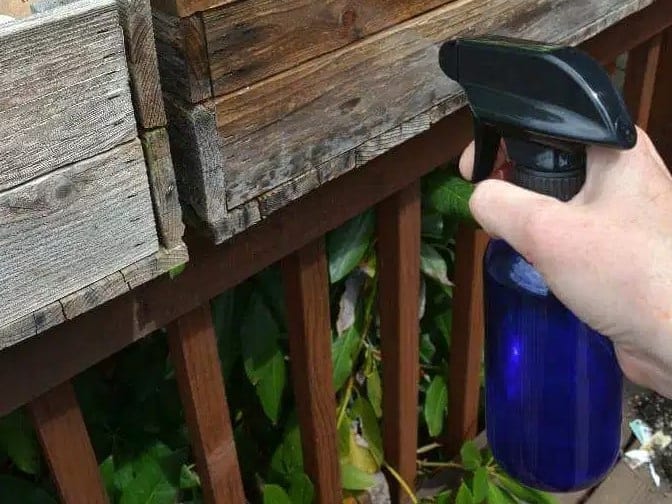
5. Use Neem Oil
Neem oil is already used widely as an organic alternative to pesticides and other chemical-based insect extermination products. It is a potent substance that can kill more than 200 species of insects and pests. That is why neem oil is the top choice for organic gardening and farming.
The great thing about neem oil is that it is not harmful to humans. In fact, it is also used in various skin care routines. It is not damaging to wildlife as well.
6. Throw Away Standing Water
Little tiny black bugs in houses, such as gnats and mosquitoes, thrive in standing water, especially those that are unclean. Stagnant water found in garbage bins at home and in dumpsites is the best area for these little bugs. So, it would be best to clear out any stagnant water supply as soon as possible.
7. Ventilate at Risk Areas
Basements, attics, and crawl spaces are the best areas for little black bugs to live and breed. Make sure these parts of your home are well ventilated to prevent moisture build-up and to keep bugs out.
For more on tiny ants in the kitchen, see the article: Tiny Ants in the Kitchen: How to Get Rid of Them
Conclusion – Little Black Bugs in House
There are many different types of little black bugs in our homes that we can’t see with our eyes. Understanding what they look like, how they live, eat, and breed can help set up better controls to safeguard our homes.
To summarize, here are the little black bugs in the house that we typically see:
- Carpet Beetles – Feeds on fibers, hairs, and cereals but are generally harmless to humans.
- Grain Insects – Destroys flours and grains by laying eggs on them.
- Fleas – Harmful to both pets and humans, causes pain and discomfort through bites.
- Pill Bugs – Love moist outdoor areas and live in colonies of thousands.
- Centipedes – Help eliminate other little black bugs in the house, although creepy in appearance.
There are more of these little black bugs in the house, and it is wise to do your research first before trying to get rid of a huge colony inside your cupboard. You can always go for a chemical-based product to exterminate these pests, but if you have pets or kids in the house, this option might not be the best idea.
You can also call a professional pest control company, especially when the bug infestation is already out of control. It will cost you money, of course, and probably time away from your home if the whole house needs to be cleaned. A professional pest control visit costs an average of $300 to $550. If you have the money, this could be your best option.
But if the little black bugs in your house are still controlled, you can try any of these easy, safe, and chemical-free options:
- Clean out your food pantry and get rid of old, damaged products, especially cereals, flours, and grains.
- Tidy up your closets and dressers periodically so as not to encourage bugs to breed and feed on clothing.
- Use diatomaceous earth (DE), a substance safe to humans and pets but very deadly to little bugs.
- Try natural oils like peppermint and neem oil.
- Get rid of stagnant water from all areas in your home.
- Ensure proper ventilation of the dark areas in your house, such as attics, basements, and crawl spaces.
The key is to keep your home clean and tidy always as little black bugs in house thrive mostly in dirty and disorganized spaces. Schedule clean-ups periodically and make sure to throw out expired, old, and damaged goods. They can be the breeding grounds for more of these little black bugs.
Read next:
Tiny White Bugs in the Kitchen [What Are They and How to Get Rid of Them]
Tiny Black Bugs in Bathroom [What Are They? How to Get Rid of Them?]

![Tiny Black Bugs in Bathroom [What Are They? How to Get Rid of Them?] tiny black bug in bathroom](https://howchimp.com/wp-content/uploads/2021/05/tiny-black-bug-in-bathrooms-6-300x200.jpeg)
![Baby Brown Recluse Spider: How to Identify, Is It Dangerous? [With Pictures] baby brown recluse](https://howchimp.com/wp-content/uploads/2021/05/baby-brown-recluse-300x200.jpg)



